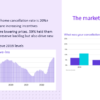Key Take Aways from Northern New Jersey’s February 2022 Meeting
- According to Charles Heydt (Dresdner Robin), the industrial market remains hot; he expects an influx of adult-use cannabis properties once NJ State opens its new cannabis project portal in March; they will review land use rights and site plan approvals. On another note, $500M in real estate transactions took place via the “metaverse” in 2021, a figure expected to double in 2022.
- Tony Ianuale reported that Dresdner Robin’s business was back to normal in 2021; he expects an increase in infrastructure work this year. As ULI co-chair, Tony announced the resumption of its Annual ULI Awards Dinner on May 5th, inviting members to submit up to four entries.
- Paul Hacker (Axis Insurance) reported that his firm started to see an increase in liability coverage due to COVID; workman’s comp is going up as more employers are sued for lack of adequate protocols resulting in employee/family illness and deaths. Cyber coverage continues to be a nightmare.
- Lucas Grunberger (Tulfra Real Estate) noted that supply chain issues continue, especially for underground structures and pipes as well as appliances. Some appliance manufacturers are discontinuing low-selling models at the last minute. Tulfra’s North Haledon residential project is on schedule for July completion. 78 of the 90 completed units are leased; 45 units will be done in April and the last 45 in July. Rental rates are 20% higher than projected in the proforma – typically 1-BRs @ $2600/month and 2-BRs @ $3,000+/month. One reason is the influx of new renters downsizing after high-profit sales of 3,000 SF or more homes.
- Greg James (NAI James Hanson) shared that interest rates have risen substantially since Thanksgiving, flattening the yield curve by 20 basis points between 5-year loans at 160 and 10-year-loans at 180. The CMBS market is still an option, offering the best proceeds although rates are higher. He expressed concern about a possible 4-5% inflation rate resulting from the government printing and circulating an enormous amount of money in the last 24 months (from $4T to $25T) as compared with a $500M to $4T increase between 1960 and 2020. Greg reported the doubling of industrial land prices from $4-6M/acre to $8M/acre between the Meadowlands and the Driscoll Bridge; in Lodi, a 5-acre site went for $4.5M/acre and rent for an 80K SF industrial building was $18-20/SF, both more than double the rates 5 years ago.
- Jonathan Kristofich (NAI James Hanson) noted that the market is hot and super busy on the industrial and multifamily land side. He is focusing on developing properties while the rates are low and there is still liquidity in the marketplace.
- Paul Abramson (SolarKal) reported an uptick in discussions of ESG and solar energy. He is keeping a close eye on developments in Washington DC. Although the Federal Build Back Better bill did not pass, there is a separate bill on climate change in development that includes $300B for solar energy.
- Paul Fiorilla (Yardi Systems), who studies the US & Canadian multifamily outlook as well as the self-storage industry, has just completed the 2022 outlook reports for both sectors. Self-storage has had the best year ever nationally. There has been moderate growth in multifamily with rents up $8/month nationally. There are more than 800K multifamily units under construction, and demand for apartment units and single-family rentals will continue to be high. Young people do not have the same interest in buying and maintaining a house or condo.
- Guest Jack Linefsky (Value Companies), whose firm owns, manages, and develops more than 3,000 rental apartment units in northern NJ, reported that the current rental market is strong. However, they were clobbered with COVID issues and delinquencies initially.
- Speaker Eric Mason, senior vice president and team leader with OceanFirst Bank, provided an overview of the bank’s role and services for the real estate market.
- As of 2022, banks can no longer use LIBOR as underlying loan rate; they have to use either SOFR (secured overnight financing rate) or the Bloomberg index. OceanFirst utilizes SOFR.
- Loans to value have become more conservative since COVID. The office and retail markets are at 65% value; industrial and multifamily go up to 75%.
- While runaway inflation and rate hikes have been predicted for the past 10-13 years, low rates and low inflation have so far prevailed. They remain points to monitor.
- Ocean First Bank is building up its construction group and needs more bankers and analysts to handle the work.
- The Bank is expanding, partnering with Bank Corp in the DC market. $13M of OceanFirst bank assets serve communities from northern Virginia and Delaware to Boston MA.





Recent Comments